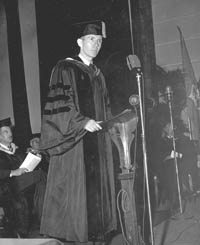Difference between revisions of "Academic regalia"
Absentminded (talk | contribs) (→Colors and standardization) |
Absentminded (talk | contribs) (→Trivia) |
||
| Line 138: | Line 138: | ||
*Professor [[Wm. Theodore de Bary]] wears the Columbia doctoral robe that he wore when receiving his first honorary degree (D. Litt., St. Lawrence, 1968) with the hood that he wore when recieving his last honorary degree (D. Litt., Columbia, 1994). | *Professor [[Wm. Theodore de Bary]] wears the Columbia doctoral robe that he wore when receiving his first honorary degree (D. Litt., St. Lawrence, 1968) with the hood that he wore when recieving his last honorary degree (D. Litt., Columbia, 1994). | ||
*Professor [[Eric Foner]] wears a tartan hood from the one school that has ever given him an honorary degree when participates in [[Commencement]] related activities - [[Iona College]], a small catholic college in [[New Rochelle]], a city in southern [[Westchester]]. | *Professor [[Eric Foner]] wears a tartan hood from the one school that has ever given him an honorary degree when participates in [[Commencement]] related activities - [[Iona College]], a small catholic college in [[New Rochelle]], a city in southern [[Westchester]]. | ||
| + | |||
| + | ==References== | ||
| + | <references/> | ||
==Gallery== | ==Gallery== | ||
Revision as of 03:14, 23 July 2010

Academic regalia, colloquially known as the "cap and gown" or "graduation robes", is the formal attire worn by degree candidates during various ceremonial occasions.
Columbia's caps and gowns were once all black. Jacques Barzun, while Provost of the University, is usually credited with changing the attire to a slate grey, determining that the lighter colored robes were more comfortable in the summer heat. They have since become light blue to match the school colors.
Contents
History
As the earliest European universities were founded as seminaries and monasteries, the earliest scholars were required to don monastic habits. This was as much practical as demanded by religious tradition -- universities were often housed in unheated castles and it could get quite cold. As medieval universities gradually gave way to secular centers of learning, the academic regalia, now known as the academic habit was retained.
The rules of academic costume at English universities was first brought to the colonies by King's College, which adopted the rules then in force at Oxford. Harvard, Yale, and Princeton subsequently took their cues from King's and adopted similar rules.[1]
Notably, at Columbia University, students were once required to don academic regalia at all times while on campus. This only ended in 1864. Now, at the University of Cambridge and the University of Oxford, academic regalia is only required during Convocation, examinations, and Commencement. At most American universities, including Columbia, it is only required during Commencement.
Tradition and hierarchy
Academic habits vary with respect to the degree conferred and the level of scholarship attained by the wearer. The bachelor's gown is a simple cotton garment that covers the entire body. The master's gown is supposed to be made of silk, though it is often made of cotton as well with the addition of longer, closed sleeves. The doctoral robe (both research and professional doctorates) is usually the most elaborate. It is made of velvet, with stripes on the arms, and includes a hood signifying the holder's area of scholarly interest. University administrators, such as the University President and various Deans, usually wear even more elaborate attire.
Headgear
Bachelors and masters usually wear the square mortarboard. Doctoral students and faculty usually wear the softer tam.
Colors and standardization
There is very little rhyme, reason, or standardization with respect to American academic regalia today (though, to be fair, the European system is even worse). An effort was made in 1893, when the American Intercollegiate Commission met at Columbia University, chaired by Seth Low, to decide on a uniform code of attire. A code was adopted in 1895, with technical advisor Gardner Leonard devising a method for indicating individual schools in otherwise standardized uniforms. Hoods would be lined in silk with the school's own colors in such a way as to form a heraldric chevron.[2] In 1932 a new commission was authorized by the American Council on Education to promulgate new rules, and in 1959 another committee further revised the rules. However, by the mid-20th century, universities had begun to go their own route once again.
For faculty and doctoral robes, however, the following holds true: the robe itself is specific to the university, while the hood trim indicates the academic discipline. This is why some faculty members march in NYU, Cambridge, and Harvard robes. In addition, the faculty member wears the robe indicative of his or her highest degree. If the highest degree is an honorary degree, then the faculty member has a choice on whether to wear the robe of the school that conferred the honorary degree, or the one that conferred his highest earned degree.
The specific discipline colors are as follows:
Trivia
- Professor Wm. Theodore de Bary wears the Columbia doctoral robe that he wore when receiving his first honorary degree (D. Litt., St. Lawrence, 1968) with the hood that he wore when recieving his last honorary degree (D. Litt., Columbia, 1994).
- Professor Eric Foner wears a tartan hood from the one school that has ever given him an honorary degree when participates in Commencement related activities - Iona College, a small catholic college in New Rochelle, a city in southern Westchester.


